A Landscape Shaped by Water
A millennium ago, the Broads region was a thriving expanse of nutrient-rich marshland. The Domesday Book records sheep grazing on these fertile grasses, supporting Norwich’s booming wool trade. However, over the centuries, the land gradually sank while sea levels rose. By the mid-13th century, chronicler John Oxnead of St. Benet’s Abbey documented increasingly severe floods and tidal surges that devastated communities. In 1287, a catastrophic breach along the coast between Winterton and Waxham allowed the North Sea to flood inland, with similar destruction recorded as far as Friesland. Desperate accounts tell of people and livestock seeking refuge in churches and boats as the waters rose.
The crisis worsened in the 17th century. In 1601, the sea breached the coast at Eccles, inundating the marshes with saltwater and destroying freshwater ecosystems. Another devastating flood in 1608 reached as far as Stalham, Coltishall, Norwich, and St. Olaves, threatening livelihoods dependent on grazing and fishing.
Engineering a Solution
In response, Parliament passed an act in 1610 under King James I to strengthen riverbanks and coastal defences. By 1625, the Sea Breach Commission sought long-term solutions, including raised causeways, reinforced dunes, and sluice gates. Among the proposals was mathematician Mr. Briggs’ idea to use windmills or horsemills to pump water from the marshes into the River Thurne.
Wind-powered drainage pumps had already been employed in the Cambridgeshire Fens by the late 1500s and soon spread to Norfolk and Suffolk. By the late 18th century, windmills dotted the landscape—William Faden’s 1798 map recorded 15 across the region.
Innovations in Drainage Technology
Early mills were simple wooden structures with cloth sails or horse-driven capstans, using paddle wheels to lift water over embankments. Over time, sturdier brick towers replaced these fragile designs, with the oldest surviving example being Oby Mill, built in 1753.
These early mills relied on tail-poles to manually pivot into the wind, while canvas-covered sails required low placement for easy operation. The 19th century brought significant advancements: cast-iron mechanisms replaced wooden components, and the 1807 invention of patent sails allowed taller, more efficient designs. Later additions, like fantails for automatic wind alignment and turbines to replace scoop wheels, further improved performance.
The Industrial Revolution introduced steam-powered pumps, identifiable by their tall chimneys, and later, diesel engines. Yet windmills persisted well into the 20th century—Ash Tree Level Mill operated until 1953, when a gale destroyed its sails.
A Lasting Legacy
Today, 63 mills remain as testaments to centuries of human ingenuity in water management. This collection represents the UK’s largest concentration of historic wind-powered pumps, surpassed only by the Netherlands. Most are 19th-century brick towers with distinctive boat-shaped caps, though rare examples like Herringfleet’s wooden smock mill still stand.
Modern drainage now relies on computerised sluices and electric pumps, yet the legacy of wind power continues with offshore turbines near Yarmouth, generating energy for today’s systems.
The Halvergate Marshes Conservation Area, home to 28 listed buildings and a Scheduled Ancient Monument, safeguards this heritage. However, many mills are at risk, prompting restoration efforts by the Broads Landscape Partnership. By training a new generation in heritage crafts, these iconic structures—and the landscape they shaped—can endure for future generations.
Iconic Windmills of the Norfolk Broads
The Norfolk Broads are home to some of the most historic and picturesque windmills in England. From drainage mills that once reclaimed marshland to traditional flour-grinding windmills, these structures are a testament to Norfolk’s engineering heritage. Here are just some of the most notable ones you can visit today.
Hunsett Mill: A Broads Icon
Perched gracefully on the east bank of the River Ant, just north of Barton Broad, Hunsett Mill stands as one of Norfolk’s most picturesque landmarks. Built in 1860 from distinctive red brick, this 12-meter-high drainage mill retains its original exterior charm despite losing its internal machinery during the 1960s modifications.
The adjacent mill keeper’s cottage, constructed around the same time but to more modest standards, has undergone several transformations due to repeated flooding, with major renovations in the 1910s, 1940s, 1950s, 1970s, and most recently in 2008. Originally a simple two-room dwelling on a raised mound, it has evolved while the mill itself remains frozen in time.
Now a Grade II listed structure, Hunsett Mill is arguably the most photographed windmill in the Broads, its idyllic riverside setting making it a staple of postcards and landscape photography.

The How Hill Windmill Trio
Nestled along a scenic stretch of the River Ant near Ludham, three remarkable drainage mills—Turf Fen Mill, Boardman’s Mill, and Clayrack Mill—form one of the Broads’ most significant historical groupings.
Turf Fen Drainage Mill
Built in the late 19th century by Stalham millwright William Rust, this Grade II* listed tower once drained surrounding marshes into the River Ant. Damaged in the Great Flood of 1912, it fell into disrepair until a 1980s restoration by John Lawn.
What makes Turf Fen unique is its dual scoopwheel system, allowing operators to switch between high and low speeds. The 31-foot brick tower, topped with a boat-shaped cap, remains a striking riverside landmark, though its sails are currently removed for restoration. Visitors can admire it from How Hill’s moorings on the opposite bank.
Boardman’s Mill
This rare open-trestle mill (one of only three surviving in Norfolk) was built around 1897 by Dan England of Ludham. Named after Edward Boardman, architect of How Hill House, it ceased operation in 1938 after storm damage.
Standing on four brick piers, the Grade II* listed structure originally used a scoopwheel before being fitted with an Appold turbine. Though currently missing its fantail and sails, its skeletal frame remains an impressive sight. Visitors can reach it via the riverside path from Toad Hole Cottage.

Clayrack Mill
A hollow-post mill relocated to How Hill in the 1980s, Clayrack was rescued from Ranworth Marshes, where it lay in ruins. Restored by Richard Seago, it now stands as a charming example of a smaller drainage mill, complete with an 8-bladed fantail and single-shuttered sails.
Like Boardman’s Mill, it can be accessed via the How Hill estate footpath, offering a fascinating glimpse into Norfolk’s marshland heritage.
Together, these three mills showcase the engineering ingenuity that shaped the Broads—and continue to captivate visitors with their timeless beauty.
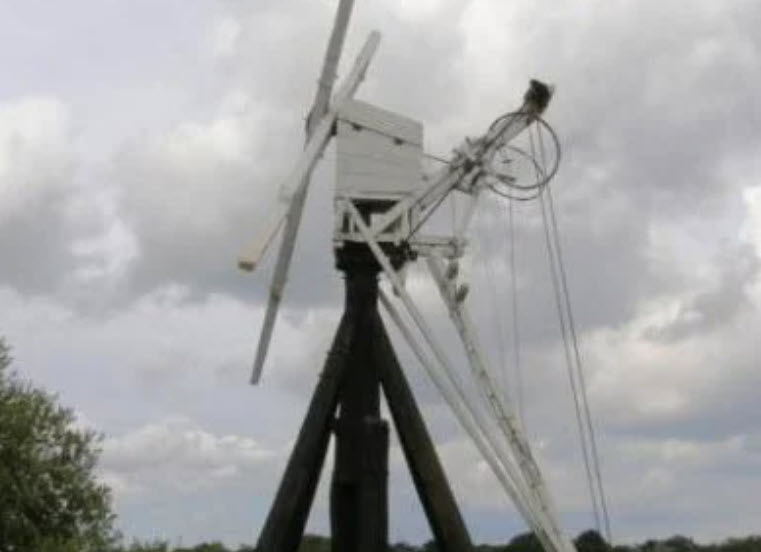
Thurne Mill
Standing proudly in the riverside village of Thurne, this iconic drainage mill was built in 1820. After falling into disrepair in the 1930s, it was lovingly restored in 1950 by brothers Bob and Albert Smith. Today, the mill opens on select days each year, relying on public support to keep its sails turning. When closed, visitors can admire it from The Lion Inn opposite or enjoy its reflection on the River Thurne while boating.

Bircham Windmill
Unlike the Broads’ drainage mills, Bircham Windmill harnesses coastal winds to grind flour in the heart of North Norfolk’s countryside. One of the few surviving mills of its kind, it offers a fascinating climb up five floors to the fan deck, complete with informative displays and audio commentary. On windy days, visitors can watch the sails and milling machinery in action. The on-site bakery sells fresh bread and treats made from the mill’s flour, and there are even bread-making workshops available.

Stracey Arms Drainage Mill
Perched beside the River Bure, this 19th-century mill is undergoing restoration but still offers guided tours at scheduled times. A charming tea room and gift shop operate year-round, and children will love meeting the resident farm animals. Its convenient location near Great Yarmouth makes it a perfect stop for those exploring the coast.
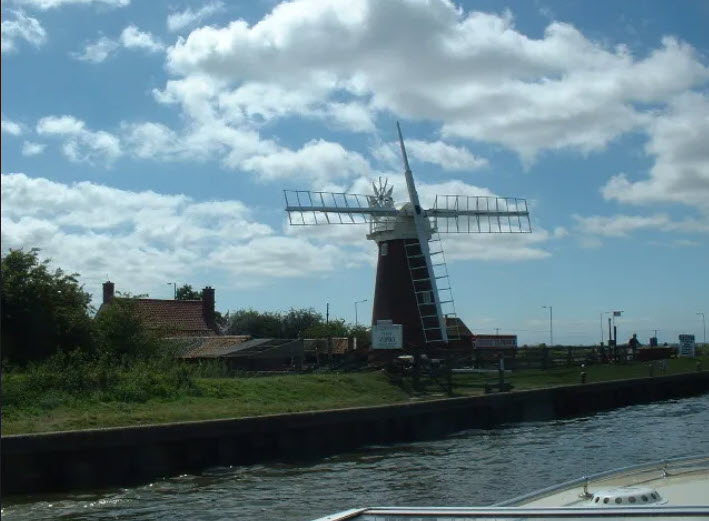
Little Cressingham Mill
A rare hybrid of wind and water power, this mill sits near the River Wissey, close to Thetford Forest. While the mill itself isn’t always open, the surrounding countryside offers scenic walks. Nearby, The Olde Windmill Inn—a 17th-century pub—provides a cosy spot for refreshments.
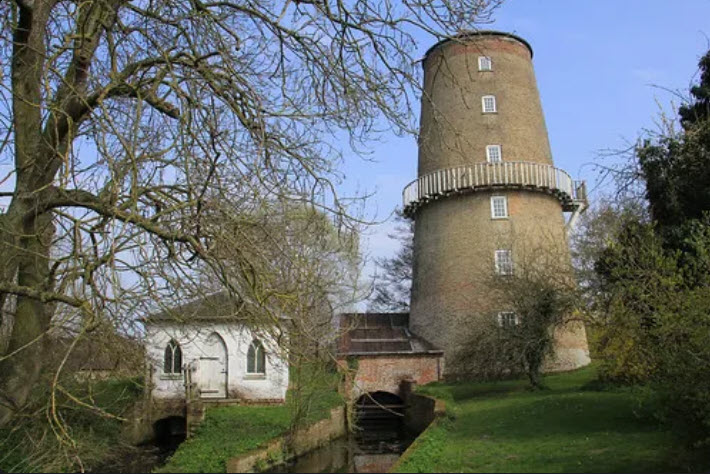
Denver Windmill
Near the market town of Downham Market, Denver Windmill dates back to 1835. After being struck by lightning in 1941, it fell silent until a full restoration brought it back to life. Today, it produces flour once again, and visitors can enjoy homemade cakes and light lunches at the Millstone Tearooms in its grounds.
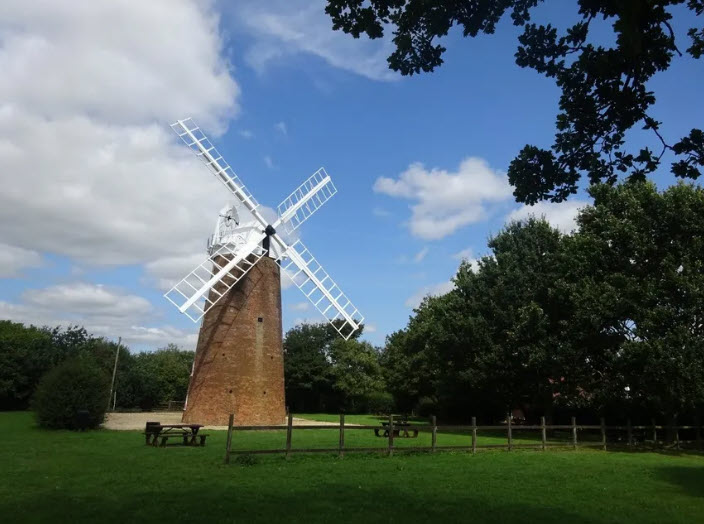
Stubb Mill
This early 19th-century drainage mill, now managed by the Norfolk Wildlife Trust, overlooks the Hickling Broad nature reserve. A prime spot for birdwatching, the reserve is home to marsh harriers, bitterns, and great crested grebes. Access is through the Hickling Broad Visitor Centre, where walking trails and boat trips offer fantastic wildlife encounters.
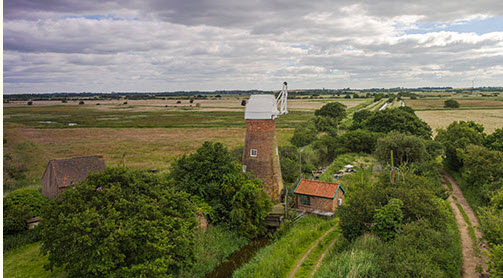
Hardley Windmill
One of the Broads’ most active drainage mills, Hardley Windmill, still operates using sail power to pump water from the marshes. Located near Reedham on the River Yare, it opens from April to September, allowing visitors to climb to the top for sweeping views. Outside these months, it can be admired from the Wherryman’s Way footpath or by boat. A visitor centre showcases its history and local wildlife, with a café serving homemade cakes.

Horsey Windpump
A National Trust treasure, Horsey Windpump was built in 1912 and recently restored after decades of stillness. Visitors can ascend the tower for breathtaking views before exploring the wildlife gardens, home to rare swallowtail butterflies. Walking trails lead through grazing marshes and dunes to a seal-populated beach. The on-site tea room offers a perfect vantage point to watch the sails turn against the Broads’ vast skies.

Preserving Norfolk’s Windmill Heritage
These historic structures are more than just landmarks—they are living monuments to Norfolk’s battle against the tides and its agricultural past. Many rely on restoration efforts and visitor support to survive, ensuring future generations can continue to enjoy their beauty and engineering brilliance. Whether you’re a history enthusiast, nature lover, or simply seeking a scenic escape, Norfolk’s windmills offer a unique glimpse into the region’s past and present.
